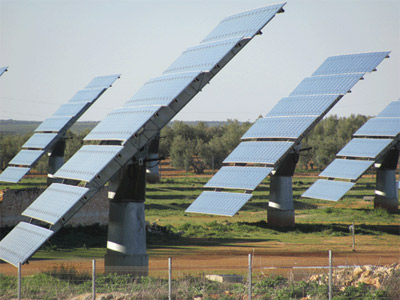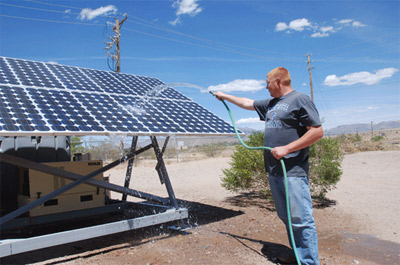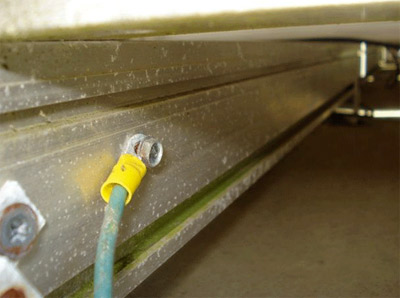 Photovoltaic (PV) power systems have PV modules and PV arrays that will be producing dangerous amounts of voltage and current for the next 50 years or more. If the inverters in these systems do not fail or are maintained in operating condition, significant amounts of energy will be supplied to local loads and to the connected utility grid. There are two areas of PV systems that deserve the attention of inspectors to ensure the safety of the public over these very long periods of time. One is proper grounding of the PV array and the entire system and the other is ensuring that the ac output connections have been properly made to the existing premises wiring. Plan reviewers can look at conductor types with an eye to durability and longevity.
Photovoltaic (PV) power systems have PV modules and PV arrays that will be producing dangerous amounts of voltage and current for the next 50 years or more. If the inverters in these systems do not fail or are maintained in operating condition, significant amounts of energy will be supplied to local loads and to the connected utility grid. There are two areas of PV systems that deserve the attention of inspectors to ensure the safety of the public over these very long periods of time. One is proper grounding of the PV array and the entire system and the other is ensuring that the ac output connections have been properly made to the existing premises wiring. Plan reviewers can look at conductor types with an eye to durability and longevity.Grounding is particularly important to the long-term safety of a PV system. See the “Perspectives on PV” article in the May-June 2010 issue of theIAEI Newsfor some history and a more complete discussion of this subject. In areas where heavy rains are infrequent, the PV modules will accumulate layers of dirt, soot and bird droppings that will reduce the electrical output. Where these modules are visible, where conscientious (green minded) people are involved, or where power purchase agreements are involved, these modules will get washed (photo 1). This is done generally with a garden hose and sometimes at close range. Few people realize that the conductive connections inside the modules and the exposed single conductor cables from the modules to other portions of the PV system operate from 60 to almost 600 volts direct current (dc) — depending on system design and configuration — and some of the newer systems with micro inverters or AC PV modules have 120- or 240-volt alternating current (ac) circuits on the roof. Standards written by Underwriters Laboratories have established that shock hazards can exist at voltages as low as 30 volts in wet conditions.

Photo 1. Cleaning the PV array may be hazardous to your health.
People, who grew up on a farm, learned at an early age whatnotto do against an electric fence. Damage to the PV module or to any exposed conductors may pose similar shock hazards to unwary people washing their PV modules. Also, workers on the roof repairing the roof, gutters, HVAC equipment and the like could also be exposed to shock hazards, especially if the roof and the PV array are wet from recent rains.
When PV systems are installed in full compliance with the requirements of theNational Electrical Code(NEC), and any local codes, and with high levels of workmanship, these PV systems will be essentially hazard free for many years. It is up to the inspector to ensure that the installation is code-compatible and that the workmanship is high.
Module Grounding
As a first requirement, the grounding instructions and labels provided with or on the PV module should be followed. If any type of listed grounding device is suggested, used, or supplied, that device must be used in accordance with the instructions provided and the instructions and labels for the module. Unfortunately, installation instructions for installing some of the common, over-the-counter grounding devices, like the lay-in lug, are not easy to find, even when available.

Photo 2. Grounded for 50 years?
The instruction manuals for many modules have not been reviewed recently by the listing/certification agencies (UL, ETL, CSA, TUV). This is done every five years and in many cases, the grounding instructions were not properly reviewed initially because of the way in which UL Standard 1703 (Flat Plate PV modules) is written with respect to grounding the module. In late 2007, UL issued a Critical Requirements Decision on UL 1703 with several reinterpreted and reemphasized requirements.
Dissimilar metals should not come into contact. At the grounding point, the field-installed copper conductor should not touch the aluminum surface of the module frame. If these two metals come into contact, and there is moisture in the air, the aluminum surface may be eaten away causing the contact/connection to fail.
Where an electrical contact is made to an aluminum framed PV module, the clear coating anodizing and oxidation should be penetrated or removed. In some cases, listed grounding devices have sharp contact points that can penetrate those insulators. In other cases, the module frame must be prepared to remove these insulators before the grounding device is used.

Photo 3. Load side, supply side or both?
Although stainless steel can come into contact with aluminum, a stainless steel washer may not be adequate to isolate a copper wire from aluminum when the electrical connection is through a screw holding the assembly together. Normally in electrical equipment, mechanical fasteners like screws, washers, and nuts are used to provide mechanical force to hold the electrically conductive parts together. The screw is not normally intended to carry current and steel is not a very good conductor. When a stainless steel flat washer is placed against a module frame, there may be little current flow through the washers unless the module frame coatings have also been removed from the aluminum surface under the washer. The same situation applies when a grounding lug is attached to a module frame. The module coatings must be removed.
Many grounding devices are tin-plated copper. The instructions, when they can be found, for attaching these listed devices show flat washers against the grounding device to prevent split ring or star lock washers from digging into the relatively soft copper thereby losing their compression force. Also, the use of any type of washer that digs into the tin plating on the grounding device may remove that plating, exposing the underlying metal to corrosive/cathodic action.
Inverter AC Output Circuits
Electrical power systems are constantly being changed in both residential and commercial locations. Not only are loads being changed (without any qualified supervision), but additional circuits may be added at any time. The Smart Grid and the Smart Home may have significant impacts on these wiring systems. See “Perspectives on PV” in the July-AugustIAEI Newsfor more details on the future. If the requirements of theNECfor connecting the ac outputs of the PV systems are not carefully followed, there may be the possibility of inadvertent overloads due to the future changes. Although load circuits may be impacted by the Smart Grid and Smart Home, the utility-interactive inverter may be a unique device for some time to come and the typical electrician may not be familiar with the inverter ac output characteristics that drive theCoderequirements. Taps may be added for new loads and these taps can be detrimental to the electrical system if shortcuts are taken today in the installation of the PV system.

Photo 4. Incorrect conductor being used outdoors
First, inspectors and PV installers should recognize that the requirements of 690.64(B)/705.12(D) will generally apply to the ac output circuits and panelboards/load centers of both load-side PV connections (690.64(B)/705.12(D) and to supply-side connections (690.64(A)/705.12(A). The application of load-side requirements to supply-side connections is not widely realized, but as soon as the new supply-side service disconnect is passed, all circuits toward the inverter may have to meet load-side Code requirements (Photo 3). See “Perspectives on PV” in the November-December 2010 issue of theIAEI News.
As noted in that earlier article, conductors involved in these load-side circuits may be larger than normal, but this is not always a bad thing for the installer. The anti-islanding circuits react to the ac voltage at the inverter output terminals. This voltage is affected by the voltage drop between the inverter output terminals and the main service disconnect or the meter. In locations where the utility voltage is on the high side of the nominal voltage (120, 208, 240, 277, 480), voltage drop (really voltage rise) to the inverter may cause the voltage at the inverter to be outside the anti-islanding range, causing the inverter to shut down. Keeping voltage drop below the typical 3–5% will minimize this problem. The larger conductors required by 690.64(B) will assist in minimizing the voltage drop/rise.
For some reason, some PV systems installers sometimes forget that theNECapplies to medium voltage (over 600 volts) premises wiring. Even at 12 kV, premises wiring circuits that may carry PV currents to the utility grid are subject to 690.64/705 requirements.
Something for Plan Reviewers
Plan reviewers can check the types of conductors being used and help the PV installer get code-compliance and added durability.
USE-2 conductors undergo a 350-hour accelerated UV exposure test. This length of test time is not sufficient to allow the USE-2 conductors to be marked “Sunlight Resistant” because that marking requires a conductor or product so marked to be tested for 720 hours.
Engineers at the cable manufacturers (not the sales staff) tell me that the PV industry is requesting USE-2 with colored insulation in addition to the basic black. Requested colors are green, red, and white and the manufacturers are making and selling those colors (photo 4). All of these cables that are marked USE-2 have passed the 350 hours of UV testing. However, black USE-2 has significantly more “carbon black” than the colored insulations have and the carbon black has different particle sizes. Carbon black gives the black-colored insulation significantly greater UV resistance than the cables with lesser amounts or no carbon black. While all USE-2 cables pass the 350-hour UV test, the black cable should last much longer in the PV environment than cable with colored insulation. Note that with an annual average of 6 hours of peak sun per day in the sunny Southwest, the exposed USE-2 conductors used in PV systems are subject to 2100 hours of sunshine each year.
InNECSection 200.6, an exception allows the grounded, exposed PV conductors to be marked with a white marking even though they are smaller than 4 AWG. With this marking allowance, there is no reason for anyone to use any colored insulation. Basic black is beautiful and suitable for all occasions—as any woman will tell you.
Now on to another issue facing the PV installer. UL Standard 4703 allows the new PV Cable/PV wire to be made with thermoset insulation (synthetic rubber, found on cables like USE-2 and XHHW) or with thermoplastic insulation (PVC, found on cables like THHN). Conductors with either insulation must pass the 720-hour UV tests and all will be marked “Sunlight Resistant.” In the hot and bright desert Southwest, cables with grey PVC, thermoplastic insulation marked “Sunlight Resistant” have failed in less than 10 years of exposure. Cables such as type UF have had the outer jackets disappear, and flexible nonmetallic conduits have fallen apart in periods much shorter than the warranted life of a PV module. On the other hand, USE-2 cables with black insulation made with thermoset insulation like cross-linked polyethylene (XLP or XLPE) have been in service, on hot roofs in full sun all day, for more than 30 years with no apparent signs of degradation.
The bottom line is: For exposed use in PV systems, single conductor cables/conductors with thermoset insulation (cross-linked polyethylene) in black are highly recommended. I would forego the use of colored insulation and PVC-insulated products in these exposed installations. See NEC Table 310.13(A) / 310,104(A) and the Cable and Wire Marking Guide in the UL White Book for more information <ahref=”http: www.ul.com=”” global=”” eng=”” pages=”” offerings=”” perspectives=”” regulator=”” electrical=”” newsletters=”” “=””>http://www.ul.com/global/eng/pages/offerings/perspectives/regulator/electrical/newsletters/).
Summary
Plan reviewers and inspectors are a critical link in ensuring the long-term safety of the public where PV systems are involved. The highest levels ofCode-compliance and workmanship are required. The fully informed inspector and plan reviewer will ensure that this goal is achieved.
Errata.In the January-February 2011IAEI News“Perspectives on PV,” in Example 5, the equation should be 130 x 0.8 x 0.82 = 85.3, not 107. The answer and the rest of the example are correct.
For Additional Information
The US Department of Energy funding for providing Inspectors and the PV Industry with telephone and e-mail support from the author was terminated on March 1, 2011. Answers to your questions may be delayed or not answered at all depending on future funding. Consultation services are available on a contracted basis. E-mail: jwiles@nmsu.edu Phone: 575-646-6105
See the web site below for a schedule of presentations on PV and theCode.
The Southwest Technology Development Institute web site maintains a PV Systems Inspector/Installer Checklist and all copies of the previous “Perspectives on PV” articles for easy downloading. A color copy of the latest version (1.91) of the 150-page,Photovoltaic Power Systems and the 2005 National Electrical Code: Suggested Practices, written by the author, may be downloaded from this web site: <ahref=”http: www.nmsu.edu=”” ~tdi=”” photovoltaics=”” codes-stds=”” codes-stds.html”=””>http://www.nmsu.edu/~tdi/Photovoltaics/Codes-Stds/Codes-Stds.html
And, yes, it may be updated to the 2008 and 2011 Codes sometime this year.










Find Us on Socials